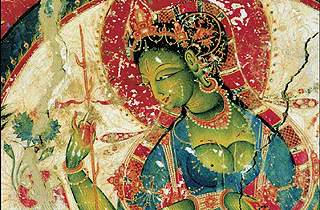On the banks of the Indus, a few kilometres from Leh, lies one of the wonders of the subcontinent — the 900-year-old monastery cluster of Alchi. Constructed between the 11th and 13th centuries, the three main temples — the Dukhang, the Sumtsek and the Manjushri Lhakhang preserve some of the oldest and artistically breathtaking mural painting preserved anywhere in the subcontinent.
The oldest of the structures is the Dukhang, or the assembly hall. The gate of the temple is exquisitely carved in wood — reminiscent of Himachali wood-carved gates from the same era. Lights are not allowed, so you have to look at the murals by torchlight. The hallucinatory coloured mandalas of a thousand Buddhas and the Vairochana mandala shine out with a three dimensional vividness that’s breathtaking. The patron goddess of the complex is Tara, and there are some stunning murals of her.
The Sumtsek is a giant three-storied structure — though public access is limited only to the ground floor. The reason for the size becomes apparent once you enter. The 13-feet-tall statues of the Bodhisattvas Maitreya, Avalokiteshvara and Manjushri dominate the sides, with their exquisitely painted dhotis. It is supposed that the Alchi complex was painted by Kashmiri artisans, and this is reflected in the distinctly Indian style of painting — ranging from form to the themes. The dhotis depict secular and religious scenes from Kashmir, as well as the lives of the 84 tantric Mahasiddha masters. Considering that none of the mural paintings from the great mahaviharas of India like Nalanda have survived, the remains of Alchi are almost miraculous in preserving the stylistic traditions of the vanished Indic Buddhist world that stretched all the way back to the paintings at Ajanta, and pointed forward to the continuation of these traditions in Nepalese and Tibetan Buddhism.




